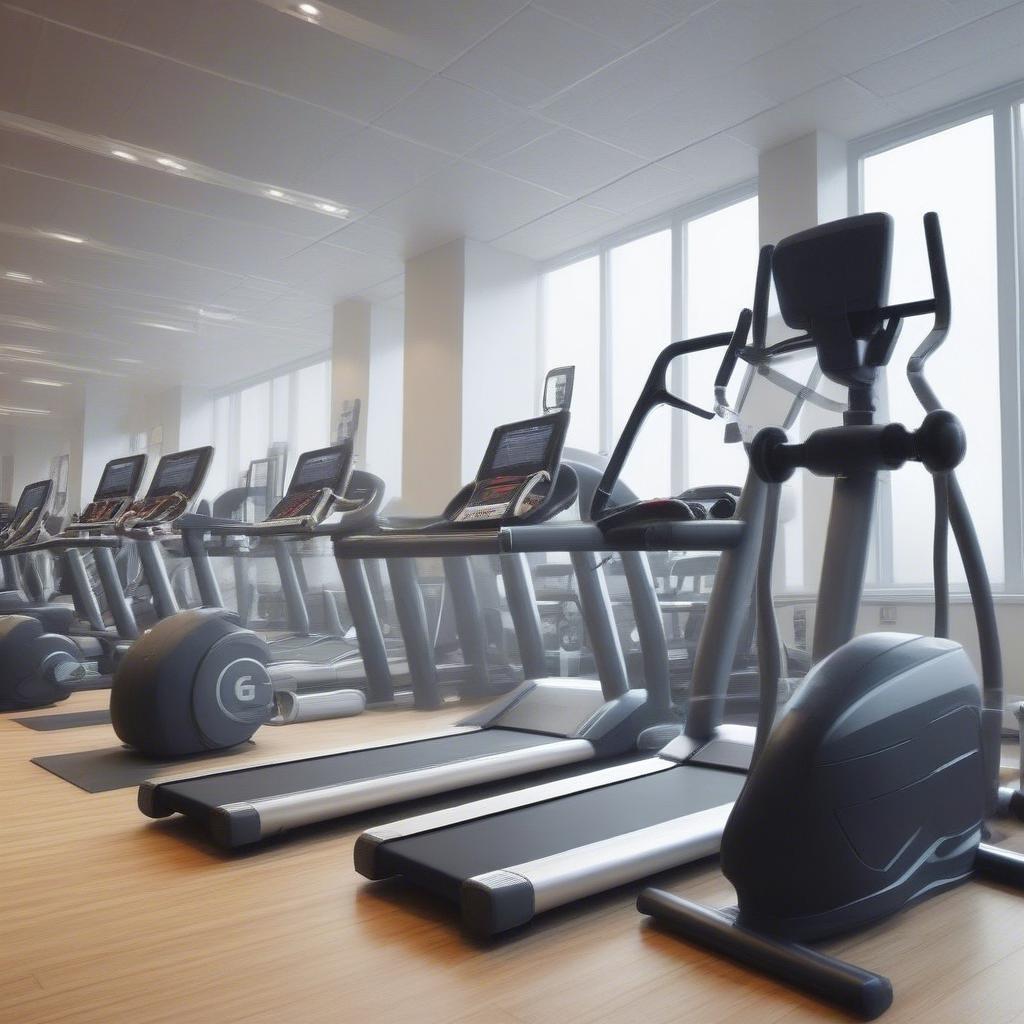
The Untapped Goldmine: Moving Beyond Just Memberships
Let’s be honest, relying solely on gym memberships for revenue is like trying to fill a swimming pool with a garden hose. It works, but it’s slow, and you’re missing out on the real potential. To truly thrive in the competitive fitness landscape, you need to tap into the goldmine of gym ancillary services. These are the extra offerings, the “add-ons,” that can significantly boost your revenue growth and diversify your fitness business. Think of them as the sprinkles on your sundae – they make everything better and more profitable. But what exactly are these services, and how can you implement them effectively? Let’s dive in.
What Are Gym Ancillary Services?
Ancillary services are those additional products or services you offer that complement your core gym membership. They’re designed to enhance the member experience, provide extra value, and, most importantly, create additional revenue streams. These go beyond the treadmills and dumbbells, addressing the holistic needs of your members.
Here are some examples to get your wheels turning:
- Nutritional Counseling & Meal Planning: Personalized plans, consultations, and even pre-made healthy meals.
- Personal Training & Coaching: One-on-one sessions, small group training, and specialized programs.
- Retail Sales: Branded merchandise, workout apparel, supplements, and healthy snacks.
- Specialized Fitness Classes: Yoga, Pilates, Zumba, dance, and more.
- Massage Therapy & Recovery: Sports massage, foam rolling sessions, and other recovery treatments.
- Childcare Services: Allowing parents to focus on their workouts.
- Workshops & Seminars: Focusing on topics like nutrition, stress management, and injury prevention.
- Spa Services: Saunas, steam rooms, and relaxation areas.
- Corporate Wellness Programs: Partnering with local businesses for employee health initiatives.
- Physical Therapy & Rehabilitation: On-site physical therapy for injury recovery.
Why Are Ancillary Services Crucial for Revenue Growth?
In today’s market, offering just a basic gym membership isn’t enough. Members expect more, and diversifying your revenue streams through gym ancillary services is no longer optional – it’s essential for sustained revenue growth. Here’s why:
- Increased Revenue: Obviously, each added service is another source of income, reducing your reliance on just membership fees.
- Enhanced Member Retention: Offering value beyond the workout floor keeps members engaged and satisfied, reducing churn.
- Competitive Edge: Differentiates you from other gyms in the area, attracting more clients.
- Meeting Diverse Needs: Caters to various interests and preferences, attracting a broader audience.
- Improved Member Experience: Providing a holistic approach to health and wellness.
- Higher Per-Member Revenue: Each member spends more money at your facility due to the extra services.
- Reduced Risk: Diversifying revenue lessens your vulnerability to market fluctuations.
- Brand Building: Positions your gym as a comprehensive wellness center, not just a place to lift weights.
When to Start Implementing Ancillary Services
Timing is everything. While it might be tempting to launch every service at once, a strategic approach is best. Here’s a general timeline:
- Initial Phase (First 6-12 Months): Focus on building a solid membership base and establishing your brand. You might start with one or two very basic add-ons, like retail merchandise (branded t-shirts) and basic personal training.
- Growth Phase (12-24 Months): Introduce more significant services, such as nutritional counseling, specialized classes, and perhaps childcare. Look at your client data to see what members might find most beneficial.
- Mature Phase (24+ Months): Expand your offerings further, potentially adding spa services, massage therapy, or even a physical therapy clinic. At this point, the data and consistent member feedback will inform next steps.
Key Considerations:
- Your Member Needs: Always prioritize what your members want and need. Conduct surveys, ask for feedback, and track popular services.
- Your Resources: Evaluate your available space, budget, and staff expertise. Start with services you can execute well.
- Your Market: Research the competition and identify unmet needs in your local area.
- Your Brand: Ensure that your ancillary services align with your brand values and image.
How to Strategically Implement Ancillary Services
Implementing gym ancillary services requires a strategic approach, not just a haphazard launch. Here’s a step-by-step guide:
Step 1: Identify Your Target Audience and Their Needs
Before you add anything, understand who your members are. Ask yourselves:
- What are their fitness goals?
- What are their pain points?
- What are their interests?
- What are their budgets?
Use member surveys, feedback forms, and even informal conversations to gather data. You can also track service usage to see what’s popular and what’s not. Once you’ve done the research, you can target specific groups with ancillary services they are more likely to use. For example, busy professionals might be interested in quick meal plans, while parents might appreciate childcare services.
Step 2: Choose Services That Align With Your Brand and Resources
Not every ancillary service will fit your gym. Consider the following:
- Alignment with your brand: Does the service fit your gym’s mission and values?
- Resource availability: Do you have the space, equipment, and staff?
- Financial feasibility: Can you realistically operate the service profitably?
- Potential ROI: Does the service have the potential to generate significant revenue?
Start with services that are relatively low-risk and have a high potential for success. For example, a basic retail section with branded merchandise is a good entry point for revenue diversification.
Step 3: Develop a Clear Pricing Strategy
Pricing is key. You need to find the sweet spot between attracting members and maximizing profits. Consider these factors:
- Cost of service delivery: Include all expenses, such as staff wages, equipment, and supplies.
- Market rates: Research what other gyms charge for similar services.
- Perceived value: Price services according to their benefits and the perceived value they provide.
- Bundling and packages: Offer discounted rates for bundled services. For example, a personal training package could include a free nutritional consultation.
- Promotional offers: Use introductory offers to entice members to try new services.
Step 4: Market Your Ancillary Services Effectively
Just because you offer a service doesn’t mean members will automatically use it. Marketing your gym ancillary services is crucial. Here are some effective marketing strategies:
- In-Gym Promotion: Use posters, flyers, and digital displays. Showcase services near their corresponding areas.
- Website and Social Media: Create dedicated pages or sections on your website, and promote services on social media platforms.
- Email Marketing: Keep members informed about new services and promotions through email campaigns.
- Free Trials and Demonstrations: Offer free sessions or consultations to encourage members to try new services.
- Member Testimonials: Showcase satisfied customers and their positive experiences.
- Referral Programs: Incentivize members to refer friends for specific services.
- Partnerships: Collaborate with local businesses to cross-promote services.
Step 5: Train Your Staff
Your staff is your first line of contact with your members. They need to be knowledgeable and enthusiastic about your ancillary services.
- Provide thorough training: Educate them about the benefits of each service and how to promote them effectively.
- Encourage cross-selling: Empower staff to identify member needs and suggest relevant services.
- Incentivize staff performance: Reward staff for promoting and selling ancillary services.
- Lead by example: Ensure your staff is well-versed and even participates in the ancillary services offered.
Step 6: Track Your Results and Make Adjustments
Continuously monitor your results and adjust your strategies as needed. Here’s what to track:
- Sales data: Track revenue generated from each service.
- Customer feedback: Gather member feedback on their experiences.
- Staff performance: Monitor how staff is promoting and selling services.
- Market trends: Stay informed of new trends and best practices.
Use this data to make informed decisions about which services to expand, adjust, or discontinue. Remember, continuous improvement is key to long-term success.
Specific Ancillary Services: Deeper Dive
Let’s explore some of the most effective gym ancillary services in more detail:
1. Nutritional Counseling and Meal Planning
Why it Works: Members are increasingly aware of the link between nutrition and fitness. They want guidance and support to make healthy food choices.
How to Implement:
- Hire a registered dietitian or nutritionist: They can provide personalized advice and meal plans.
- Offer consultations: One-on-one consultations to assess dietary needs and develop tailored plans.
- Create meal plans: Develop customized meal plans based on individual goals.
- Offer pre-made meals: Consider offering a grab-and-go healthy meal option.
- Run workshops: Educate members about nutrition and healthy eating habits.
Example: Offer different tiers of nutritional support: a basic consultation, a customized 7-day meal plan, and a monthly support package that includes check-ins.
2. Personal Training & Coaching
Why it Works: Many members need personalized guidance and motivation to reach their fitness goals. Personal training is a premium service that commands higher rates.
How to Implement:
- Hire certified personal trainers: Look for trainers with different specializations.
- Offer free consultations: Let members discuss their goals and needs.
- Create package options: Offer different packages based on the number of sessions.
- Offer group training: Smaller group sessions for a more affordable option.
- Offer specialized programs: Pre and post-natal training, injury rehabilitation, or sports-specific training.
Example: Offer packages at different price points: introductory packages, monthly training programs, and longer-term transformation plans.
3. Retail Sales
Why it Works: Members appreciate convenience and want easy access to quality fitness gear and supplements.
How to Implement:
- Create a retail space: A dedicated space within the gym is essential.
- Offer branded merchandise: T-shirts, water bottles, towels, etc.
- Stock high-quality apparel: Workout clothing and shoes.
- Provide supplements: Protein powders, vitamins, and other supplements.
- Offer healthy snacks: Protein bars, nuts, and other healthy options.
Example: Feature a “product of the month” with a special discount to promote trial and recurring revenue.
4. Specialized Fitness Classes
Why it Works: Variety is key to keeping members engaged and preventing boredom. Specialized classes attract new members with specific interests.
How to Implement:
- Offer a diverse range of classes: Yoga, Pilates, Zumba, dance, martial arts, etc.
- Hire qualified instructors: Choose instructors with expertise and a passion for fitness.
- Offer different levels: Provide options for beginners, intermediate, and advanced students.
- Create class schedules: Ensure class times accommodate different member schedules.
- Promote new classes: Use your marketing channels to spread the word.
Example: Create themed months with special class schedules, like "Yoga for Stress Relief Month."
5. Massage Therapy & Recovery
Why it Works: Recovery is an important part of any fitness routine. Massage therapy provides relief from muscle soreness and helps with overall well-being.
How to Implement:
- Hire licensed massage therapists: Look for therapists specializing in sports massage or other therapeutic techniques.
- Offer a range of services: Different massage types, foam rolling sessions, and other recovery treatments.
- Create a relaxing space: A dedicated room for massage therapy with soothing ambiance.
- Package services: Offer combo packages with training or other ancillary services.
Example: Offer “recovery days” that include massage, foam rolling, and other treatments for a discounted rate.
Maximizing Revenue Through Bundling and Packages
One of the most effective ways to increase revenue growth from gym ancillary services is by bundling different services together into attractive packages. This strategy offers benefits for both you and your members:
- Increased Value for Members: Bundling services makes them more affordable and appealing, creating a perception of value.
- Higher Spending Per Member: Members are encouraged to try multiple services, leading to increased spending.
- Improved Member Loyalty: Bundled packages often create a longer-term commitment.
- Increased Revenue for You: You can generate more income per member by packaging different service offerings.
Examples of Effective Bundling:
- The “Transformation Package”: Personal training, meal planning, and nutrition consultation.
- The “Recovery Package”: Massage therapy, foam rolling sessions, and a supplement package.
- The “New Member Package”: A free personal training session, a free class, and a discount on retail items.
- The “Family Package”: Childcare, group fitness classes, and discounted rates on personal training.
Tips for Successful Bundling:
- Offer tiered packages: Provide options at different price points to cater to different budgets.
- Clearly outline the benefits: Make sure members understand the value they’re getting.
- Offer limited-time discounts: Create a sense of urgency.
- Customize packages: Allow members to choose a package that best suits their needs.
- Market bundles effectively: Promote them on all marketing channels.
Learn Business: Your Partner for Success
Implementing gym ancillary services can be complex, and you don’t have to do it alone. Learn Business is dedicated to supporting businesses like yours by providing the guidance and tools you need to thrive.
How can Learn Business help your gym with revenue growth and fitness business diversification?
- Templates and Frameworks: Learn Business offers templates that make it easier to plan, launch, and manage your gym ancillary services. These templates cover everything from creating marketing plans to developing pricing strategies.
- Expert Guidance: You will have access to expert business advisors who can help you navigate the challenges of implementing and growing your ancillary services. We are here to offer specific support tailored to your specific business.
- Strategic Planning: We can help you develop a comprehensive business plan that includes ancillary services.
- Financial Projections: We can help you create financial projections and models to ensure your ancillary services are profitable.
- Marketing Strategies: Learn Business provides marketing strategies to promote your ancillary services, helping you attract more members and increase revenue.
By leveraging Learn Business’ resources, you can:
- Reduce the learning curve associated with implementing new services.
- Avoid common pitfalls and mistakes.
- Accelerate your growth and increase profitability.
- Maximize the potential of your fitness business and generate sustainable revenue growth.
Don’t let your gym’s potential be limited by relying solely on memberships. Embrace the opportunity to diversify your income streams through well-planned gym ancillary services. With the right strategy and support from Learn Business, you can transform your gym into a thriving, full-service wellness center.



Leave a Reply